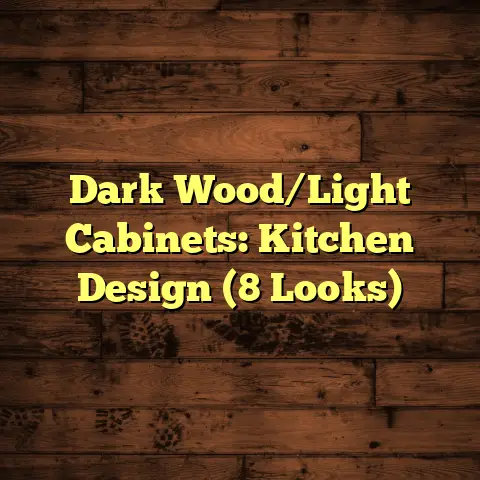Best Hardwood Grade? (1 Pro’s Top Pick!)
Have you ever walked into a room and been instantly captivated by the flooring?
Ever wondered what makes some hardwoods stand out above the rest when it comes to quality, durability, and sheer beauty?
I’m here to spill the beans on everything hardwood grades.
As a flooring contractor with years under my belt, I’ve seen it all, from disastrous DIY attempts to breathtaking, perfectly installed masterpieces.
I am going to guide you through the maze of hardwood grades and reveal my top pick.
1. Understanding Hardwood Grades
So, what exactly is hardwood grading?
Think of it as a report card for wood.
It’s a standardized system that evaluates the quality and appearance of hardwood lumber.
It’s an essential aspect of selecting hardwood flooring.
Why?
Because it directly impacts the look, performance, and ultimately, the value of your investment.
The grading system is determined by several key factors:
-
Appearance: This considers the visual characteristics of the wood, including color variation, grain patterns, and the presence of knots or blemishes.
-
Durability: This assesses the wood’s resistance to wear and tear, including its hardness and stability.
-
Natural Defects: The number, size, and type of natural imperfections, like knots, mineral streaks, and sapwood, all play a role.
Think of it like buying diamonds.
Clarity, cut, color, and carat weight all determine the diamond’s value.
Hardwood grading works similarly.
A higher grade typically means fewer imperfections and a more uniform appearance.
2. The Different Grades of Hardwood
Alright, let’s dive into the nitty-gritty of the different hardwood grades.
Keep in mind that grading rules can vary slightly depending on the species and the lumber association (like the National Hardwood Lumber Association – NHLA).
However, the general principles remain the same.
Clear Grade
This is the crème de la crème of hardwood.
Clear grade lumber is virtually free of defects.
It has a consistent color and tight, uniform grain.
Features:
- Minimal knots or blemishes
- Consistent color and grain
- The most expensive option
Advantages:
- Creates a sleek, modern look
- Provides a uniform and elegant appearance
- Maximizes the wood’s natural beauty
Ideal Applications:
- High-end residential projects
- Modern, minimalist designs
- Areas where a uniform appearance is desired
Think of a pristine, modern art gallery with flawless flooring.
That’s the Clear Grade vibe.
Select Grade
Select Grade is a step down from Clear Grade, but it’s still a high-quality option.
It allows for some minor imperfections, such as small knots and slight color variations.
Features:
- A few small knots and mineral streaks
- Slight color variation
- A balance of quality and character
Advantages:
- More affordable than Clear Grade
- Offers a touch of natural character
- Versatile for various design styles
Ideal Applications:
- Residential homes
- Transitional designs
- Projects where some character is desired
It’s perfect if you want a refined look with a hint of natural charm.
No. 1 Common Grade
This is where things get interesting.
No. 1 Common Grade offers a mix of beauty and functionality at a more budget-friendly price point.
It contains more knots, color variations, and other imperfections than Select Grade.
Features:
- More prominent knots and mineral streaks
- Greater color variation
- A rustic, character-rich appearance
Advantages:
- More affordable than Select or Clear Grade
- Adds warmth and character to a space
- Hides wear and tear well
Ideal Applications:
- Residential homes
- Farmhouse or rustic designs
- Areas where a lived-in look is desired
It’s like the comfy, well-worn leather chair of hardwood flooring.
No. 2 Common Grade
This grade, also known as “Rustic Grade,” is the most affordable option.
It features significant knots, splits, and color variations.
While it may not be for everyone, it can be a great choice for specific projects.
Features:
- Large knots, splits, and imperfections
- Significant color variation
- A very rustic, weathered look
Advantages:
- The most affordable option
- Adds a unique, rustic charm
- Hides imperfections and wear well
Ideal Applications:
- Barns, sheds, and outbuildings
- Rustic-themed projects
- Areas where cost is a major concern
Think of a reclaimed wood wall in a trendy loft apartment.
That’s the No. 2 Common Grade aesthetic.
Rustic Grade
Rustic Grade is all about embracing imperfections.
It showcases the natural beauty of the wood, with knots, wormholes, and mineral streaks adding character.
Features:
- Prominent knots, wormholes, and mineral streaks
- Significant color variation
- A natural, aged appearance
Advantages:
- Adds warmth and character to a space
- Hides wear and tear well
- Creates a unique, one-of-a-kind look
Ideal Applications:
- Farmhouse or rustic designs
- Homes with a natural, organic aesthetic
- Areas where a relaxed, lived-in feel is desired
It’s like the antique rug that tells a story with every thread.
3. Factors Influencing Hardwood Grade Choice
Choosing the right hardwood grade is like picking the perfect outfit.
It depends on the occasion, your personal style, and your budget.
Let’s break down the key factors:
-
Aesthetic Preferences: Do you prefer a clean, uniform look or a rustic, character-rich appearance?
-
Budget Considerations: Higher grades typically come with a higher price tag.
-
Intended Use: Will the flooring be in a high-traffic area or a low-traffic space?
-
Species: Different species have different natural characteristics, which can influence the grade.
Speaking of species, let’s talk about some popular choices:
-
Oak: A classic choice known for its durability and versatility.
-
Maple: A light-colored wood with a smooth, consistent grain.
-
Cherry: A rich, reddish-brown wood that adds warmth and elegance.
-
Hickory: A strong, durable wood with a rustic grain pattern.
The species you choose will also affect the available grades.
For example, some species naturally have more knots or color variation than others.
4. Expert Insights
Now, let’s get to the good stuff.
I’m going to share my personal insights, drawn from years of experience in the flooring industry.
I’ve installed hardwood in countless homes and businesses, and I’ve seen firsthand how different grades perform in different environments.
One of my most memorable projects was installing hardwood flooring in a historic farmhouse.
The homeowner wanted to preserve the original character of the home while updating the flooring.
We decided to go with No. 1 Common Grade hickory.
The knots and color variations added warmth and authenticity to the space.
The homeowner was thrilled with the result.
It was the perfect balance of rustic charm and modern durability.
5. The Pro’s Top Pick
Alright, drumroll please…
My top pick for the best hardwood grade is…
Select Grade!
Why?
It strikes the perfect balance between beauty, durability, and affordability.
It offers a refined look with just enough natural character to keep things interesting.
Key Benefits:
-
Durability: Select Grade hardwoods are typically durable and long-lasting, making them suitable for high-traffic areas.
-
Maintenance: They are relatively easy to maintain, requiring only regular sweeping and occasional mopping.
-
Aesthetic Appeal: They offer a clean, elegant look that complements a variety of design styles.
When it comes to specific brands or products, I’m a big fan of these:
-
Bruce Hardwood: Known for its quality and durability.
-
Armstrong Flooring: Offers a wide range of styles and finishes.
-
Somerset Hardwood Flooring: A sustainable manufacturer with beautiful, high-quality products.
6. Comparative Analysis
Let’s compare my top pick (Select Grade) with the other grades:
| Grade | Appearance | Durability | Cost | Best For |
|---|---|---|---|---|
| Clear | Virtually flawless, uniform | Excellent | Very High | High-end homes, modern designs |
| Select | Few small knots, slight color variation | Excellent | High | Residential homes, versatile designs |
| No. 1 Common | More prominent knots, greater color variation | Good | Moderate | Farmhouse designs, lived-in look |
| No. 2 Common | Large knots, significant color variation | Fair | Low | Barns, rustic-themed projects |
| Rustic | Prominent knots, wormholes, mineral streaks | Good | Moderate | Farmhouse designs, natural aesthetic |
As you can see, Select Grade offers a great compromise.
It’s not as expensive as Clear Grade, but it’s still a high-quality option.
It has more character than Clear Grade, but it’s not as rustic as No. 1 or No. 2 Common Grade.
7. Real-World Applications
I’ve used Select Grade hardwood in countless projects, and I’ve always been impressed with its versatility and performance.
One of my favorite projects was installing Select Grade oak flooring in a family home.
The homeowners wanted a durable, beautiful floor that would stand up to the wear and tear of everyday life.
They had two young children and a dog.
Select Grade oak was the perfect choice.
It’s tough enough to handle the kids and the dog, and it looks great with their traditional décor.
Here’s what one homeowner had to say about their Select Grade hardwood floors:
“We absolutely love our Select Grade oak floors! They’re beautiful, durable, and easy to clean. We couldn’t be happier with our choice.” – Sarah M.
Another contractor friend of mine used Select Grade maple in a modern condo.
The light color and smooth grain created a bright, airy feel.
The client was thrilled with the result.
It was the perfect complement to their minimalist aesthetic.
8. Conclusion
Choosing the right hardwood grade is a big decision.
It’s important to consider your aesthetic preferences, budget, and intended use.
I hope this article has helped you understand the different hardwood grades and make an informed decision.
Remember, my top pick is Select Grade.
I believe it offers the best balance of beauty, durability, and affordability.
But ultimately, the best hardwood grade for you depends on your individual needs and preferences.
Choosing the right hardwood flooring is an investment in your home’s beauty and value.
Take your time, do your research, and choose wisely.
You’ll be rewarded with a beautiful, durable floor that you’ll enjoy for years to come.





